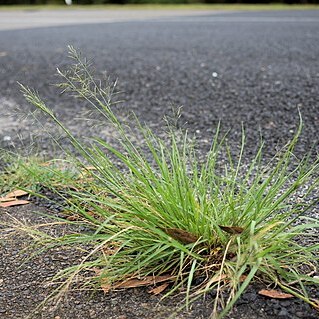Loosely tufted weak perennial or annual to 400 mm high; base strongly compressed; basal sheaths glabrous; culm without glands below nodes. Leaf blade 40-300 x 1-3 mm; margins smooth, with or without small sunken glands. Inflorescence open; lowest branches not whorled, axils glabrous or hairy; pedicels slender, annular gland present or absent. Spikelet 4-16 x 1-3 mm, linear, outline coarsely serrate; rachilla persistent; lemmas and/or paleas breaking up from the base upwards; glumes unequal, lanceolate in side view, apex acute; lower glume usually reaching up to just above base of lemma above, never up to middle; upper glume usually barely reaching to just covering base to rarely reaching the middle of lemma above; lemmas on same side of rachilla distinctly overlapping lemma above; lowest lemma 1.7-2.5 mm long, narrowly ovate in side view, acute to narrowly obtuse, lateral nerves not distinct, except sometimes near base; palea keels scaberulous, margins touching to overlapping entire length; anthers 3, 0.4-1.0 mm long; caryopsis oblong, strongly laterally flattened.
Spikelets 4–16 × 1–1.5 mm (but opening out to 3 mm wide at maturity), linear, laterally compressed, 4–16-flowered, the lemmas disarticulating from below upwards, the rhachilla persistent; glumes unequal, barely reaching or shortly exceeding the base of the adjacent lemmas (the inferior never reaching as far as the middle, the superior sometimes doing so), keeled, narrowly lanceolate to linear-lanceolate in profile, glabrous, acute or rarely concave at the apex, the inferior 0.4–1 mm long, the superior 0.8–1.4 mm long; lemmas 1.7–2.5 mm long, keeled, narrowly semi-ovate in profile (with straight keel and gibbous margins), firmly membranous with ± distinct lateral nerves, appressed to the rhachilla at first, later widely diverging, those in opposite rows not imbricate, the rhachilla visible between them, dark green, glabrous, subacute to narrowly obtuse at the apex; palea persistent, glabrous on the flanks, the keels slender, wingless, scaberulous; anthers 3, 0.5–0.9 mm long.
Tufted perennial, the basal shoots laterally compressed; culms 10–70 cm. high, erect.. Leaf-blades flat, 4–30 cm. long, 1–3 mm. wide, finely attenuate.. Panicle narrowly elliptic, 5–20 cm. long, open, bearded or not in the branch-axils, the slender pedicels with or without a glandular ring.. Spikelets 4–16-flowered, linear, 4–16 mm. long, 1–3 mm. wide, dark green, the florets at first appressed to the rhachilla, but later spreading and the spikelet-margin coarsely serrate, breaking up from the base, the rhachilla persistent; glumes lanceolate, unequal, the lower 0.5–1 mm. long, the upper 0.8–1.4 mm. long and barely reaching the base of the second lemma; lemmas oblong-elliptic, 1.7–2.5 mm. long, inconspicuously nerved, bluntly acute to narrowly obtuse; palea green, scaberulous on the keels, persistent; anthers 3, 0.5–0.9 mm. long.. Caryopsis oblong, 1 mm. long, strongly laterally flattened.. Fig. 62/8, p. 196.
Weak perennial; or annual; up to 0.4 m high; loosely tufted; plant base strongly compressed. Leaf blades 40-300 x 1-3 mm. Flowers: panicle open; not much branched; pedicels slender; spikelets 4-16 x 1-3 mm; linear; outline coarsely serrate; florets 3-16; lemmas on same side of rachilla distinctly overlapping lemma above; rachilla persistent; lemmas and/or paleae breaking up from base upwards; upper glume barely reaching to just covering base of lemma directly above; lowest lemma 1.2-2.5 mm long; ± narrowly semi-ovate in side view; apex acute to narrowly obtuse; palea keels scaberulous; anthers 3; 0.4-0.5 mm long; caryopsis oblong; strongly laterally flattened.
Loosely tufted, weak perennial or annual, up to 400 mm high. Leaf blade 40-300 x 1-3 mm; ligule a fringe of hairs. Inflorescence an open panicle; pedicels slender. Spikelets 4-16 x 1-3 mm, outline coarsely serrate, laterally compressed; lemmas on same side of rachilla distinctly overlapping lemma above; rachilla persistent, lemmas and/or paleas breaking up from base upwards; glumes shorter than spikelet, 1-nerved. Florets many; lowest lemma 1.2-2.5 mm long, entire, 3-nerved; palea keels scaberulous; anthers 3, 0.4-0.5 mm long. Flowering time Jan. (rarely Apr. Caryopsis oblong, strongly laterally flattened.
Weak perennial or annual, loosely tufted, up to 400 mm tall. Leaf blades 40-300 mm long, 1-3 mm wide. Spikelets 4-16 mm long, 1-3 mm wide. Inflorescence open, pedicels slender; spikelet outline coarsely serrate, lemmas on same side of rhachilla distinctly overlapping lemma above, rachilla persistent, lemmas and/or paleas breaking up from base upwards; upper glume barely reaching to just covering base of lemma directly above, lowest lemma 1.2-2.5 mm long; palea keels scaberulous; anthers 3, 0.4-0.5 mm long. Caryopsis oblong, strongly laterally flattened.
Caespitose perennial without rhizomes or stolons; culms up to 70 cm tall, erect, strongly compressed below, unbranched, glabrous at the nodes, eglandular; basal leaf sheaths glabrous, firmly chartaceous, strongly compressed and keeled, eglandular or with punctate glands along the keel, persistent; ligule a line of hairs; leaf laminas 4–30 cm × 1–3 mm, linear, flat, thinly pilose, eglandular.
Panicle 5–20 cm long, narrowly elliptic to narrowly ovate, loose and open, the spikelets evenly distributed on pedicels 3–7 mm long, these with or without an annular gland at about the mid-point, the primary branches not in whorls, terminating in a fertile spikelet, glabrous or pilose in the axils.
Caryopsis 0.9–1.1 mm long, oblong, strongly laterally compressed.
The leaves mostly from the tussocky base
Slender caespitose grass 30–60 cm. high

